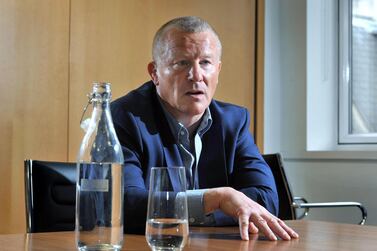Neil Woodford’s removal from the fund bearing his name marks the conclusion of a stunning fall from grace that counts as one of the most dramatic in London’s financial history.
Managers are rarely fired from funds they are synonymous with. The closest parallel in recent memory is Bill Gross’s 2014 departure from Pacific Investment Management Co, better known as Pimco, after an acrimonious dispute over his management of the company he cofounded. But the unravelling of Woodford is different because it stemmed from a crisis that is taboo in fund circles — a liquidity crunch.
Mr Woodford’s dismissal caps the most difficult chapter in a career spanning more than three decades. A fund manager at Invesco for a quarter of a century, he made his reputation by sitting out the dotcom bubble at the turn of the millennium and selling down bank shares in the run-up to the financial crisis, before setting out on his own in 2014. But bets on smaller and unlisted companies at his new firm eventually were his undoing, leaving him unable to pay back investors who wanted out.
On Tuesday, the administrator of his main investment vehicle fired Mr Woodford as the fund’s manager and said the LF Woodford Equity Income Fund will be liquidated. Mr Woodford objected, saying the decision wasn’t in the interests of long-term investors.
By Wednesday, however, Mr Woodford accepted that there was no future for his firm. He resigned from the company's two other funds, Woodford Patient Capital Trust and the Income Focus fund, and said Woodford Investment Management would close.
In the world of mutual funds, the failure to meet redemptions is akin to a breach of trust, and it’s rare that funds or their managers rebound from a freeze. Swiss money manager GAM Holding last year froze funds tied to Tim Haywood after the former star bond manager was suspended and it was unable to meet ensuing redemption requests. Haywood was eventually ousted and the firm had to liquidate its second-biggest strategy with billions of dollars in assets.
In 2016, famed US investor Robert Goldfarb retired from the firm he cofounded — Ruane, Cunniff & Goldfarb — after a concentrated bet on a troubled drugmaker marred the reputation of a mutual fund that traces its roots to billionaire Warren Buffett. But that investment vehicle, the Sequoia Fund, was able exit the troubled holding without having to suspend redemptions, and performance rebounded in recent years.
At Pimco, it took about two years to reverse outflows in the wake of Mr Gross’s departure, underscoring just how closely linked the firm was with its co-founder. But unlike Mr Woodford’s removal from his main fund, the exit of Gross largely wasn’t related to investment decisions, and the firm didn’t have to freeze its funds. Gross struggled to start a new career after joining a rival firm and retired this year.
At Mr Woodford’s firm, the damage is that much more severe because the firm is built entirely on his investing acumen. The son of a postcard printer, he stumbled into fund management after completing a degree in agricultural economics. His first role running money was at Eagle Star Insurance Group in 1987 before moving to Invesco the following year, where he would make his reputation with contrarian bets.
He kept dot-com stocks out of his portfolio at the turn of the millennium, and before the financial crisis in 2008 he began building stakes in defensive stocks like British American Tobacco and GlaxoSmithKline, while eschewing banks. Despite rocky periods — he declined to buy back those bank stocks before the post-crisis rally, for example — Mr Woodford maintained an imperious reputation, particularly among retail investors.
As his stature in the UK’s business community grew, so did his influence. In 2012 he publicly criticised the proposed merger of aerospace giant BAE Systems and French rival Airbus (then known as EADS), helping to torpedo the deal.
In 2013, Woodford announced he would leave Invesco to set up Woodford Investment Management. He oversaw about £33 billion (Dh154.7bn) in assets at the time of his departure, and big chunks of that followed him out the door. St James’s Place, the UK’s biggest wealth manager, removed £3.7 billion from Invesco and pledged it to Woodford’s firm even before it was started.
The move endowed Mr Woodford with more freedom and allowed him to invest in smaller, less-liquid and even unlisted stocks. It was these investments that would eventually lead to the suspension of redemptions from the fund, as Mr Woodford found himself unable to sell those holdings quickly enough to return money to clients.
Though he made his name in blue-chip stocks at Invesco, unshackled by the strictures of corporate bosses he indulged his venture capitalist instincts in the biotech, life-science and health-technology industries particularly.
“I strongly believe that investing in early-stage technology businesses can add meaningfully to the long-term performance of the fund,” Mr Woodford wrote in a blog post shortly before opening his Income Fund. There was a lack of investment in early stage companies and patient capital, long term money willing to wait for a company “to blossom”, he wrote.
Usually, money managers who want to invest in unlisted companies use fund structures where investor money is locked up for long periods. Woodford’s equity income fund is a more traditional mutual fund, but it’s allowed to have up to 10 per cent of its holdings in unlisted stocks, according to European rules.
After an impressive 16 per cent return in 2015, the fund’s performance dropped below peers, leading many investors to pull money. As they cashed out, Woodford was forced to sell more liquid holdings, leaving remaining clients with harder-to-sell assets. When a pension fund for the council workers of an English county asked for its roughly £260 million investment back, Woodford had little choice but to halt redemptions to prevent a fire sale.
A redemption freeze is designed to allow for an orderly sale of assets, but for investors and supporters it was the last straw. Hargreaves Lansdown, the UK’s largest listed fund broker and a long time backer of Woodford, removed his funds from a list of favourites. The mandate from St James’s Place that had followed Woodford out the door from Invesco was also pulled.







